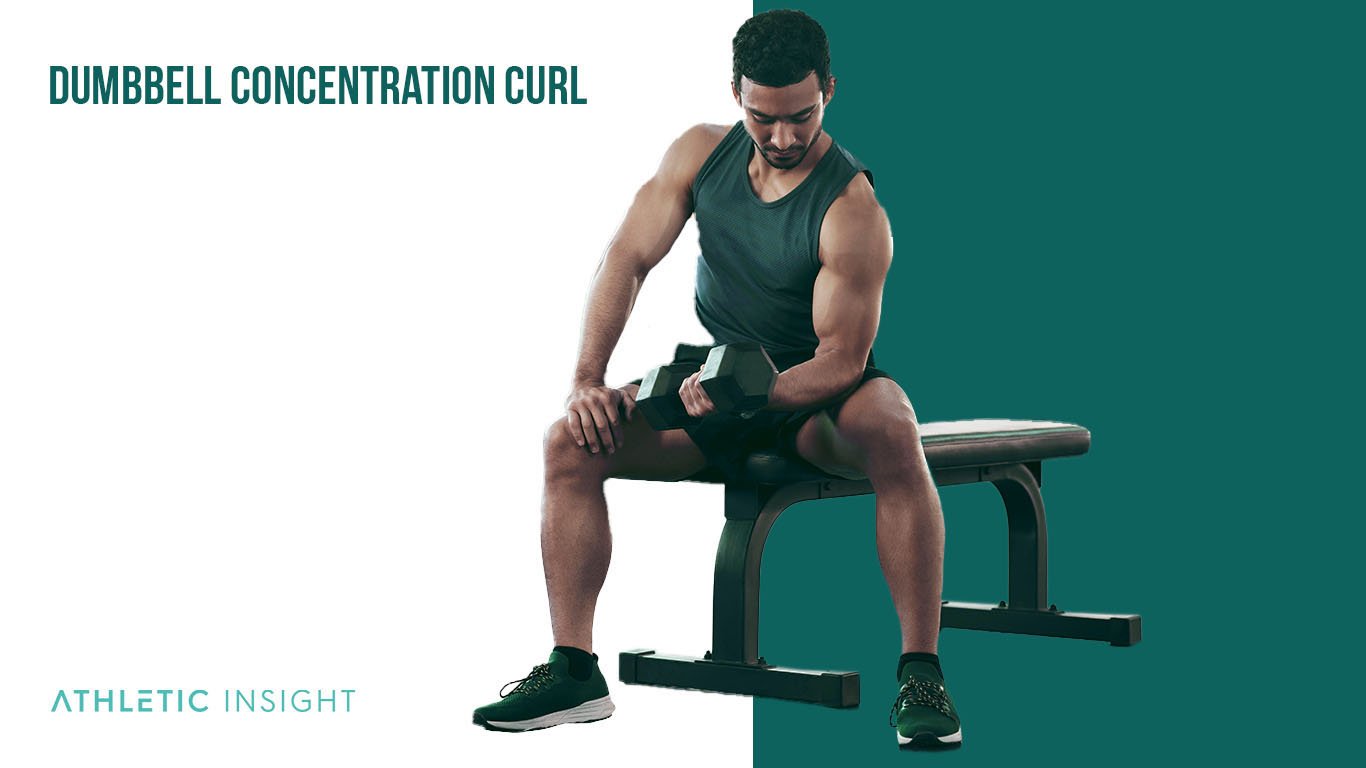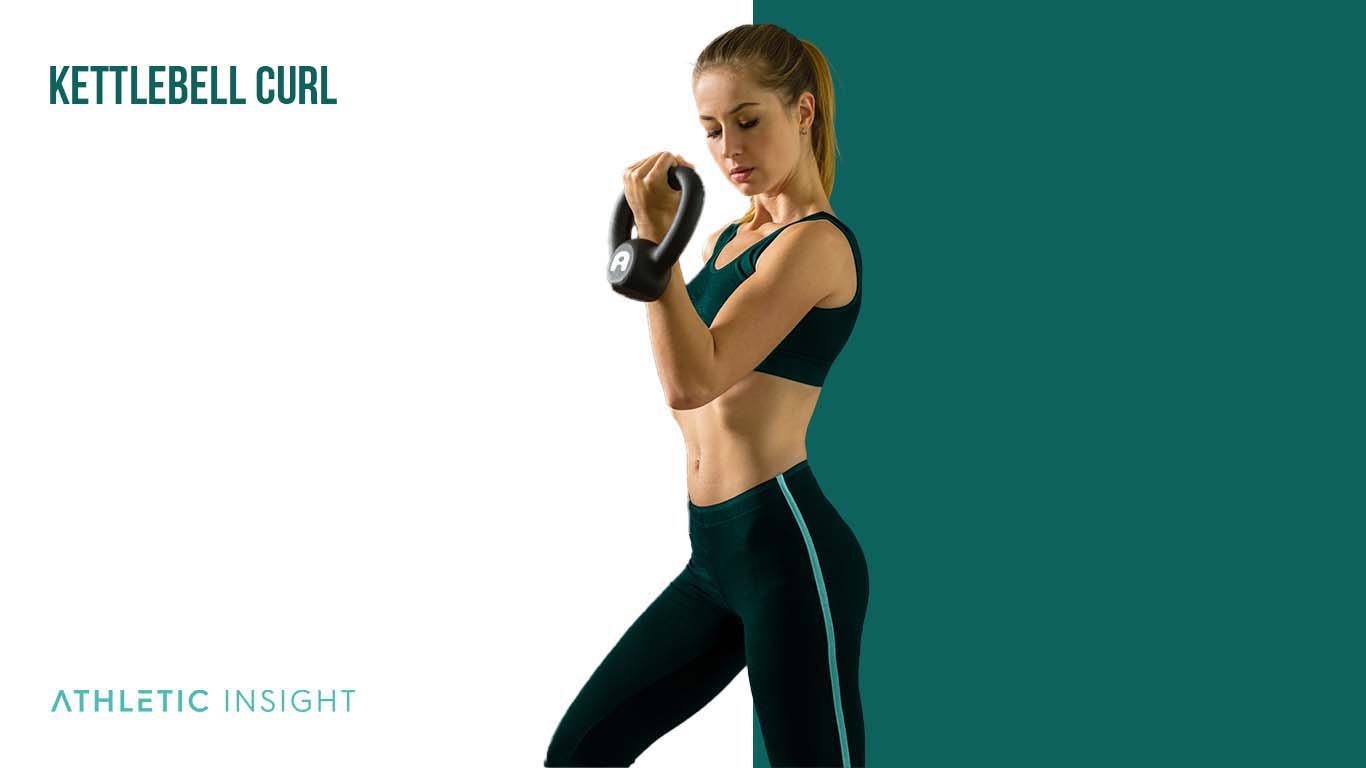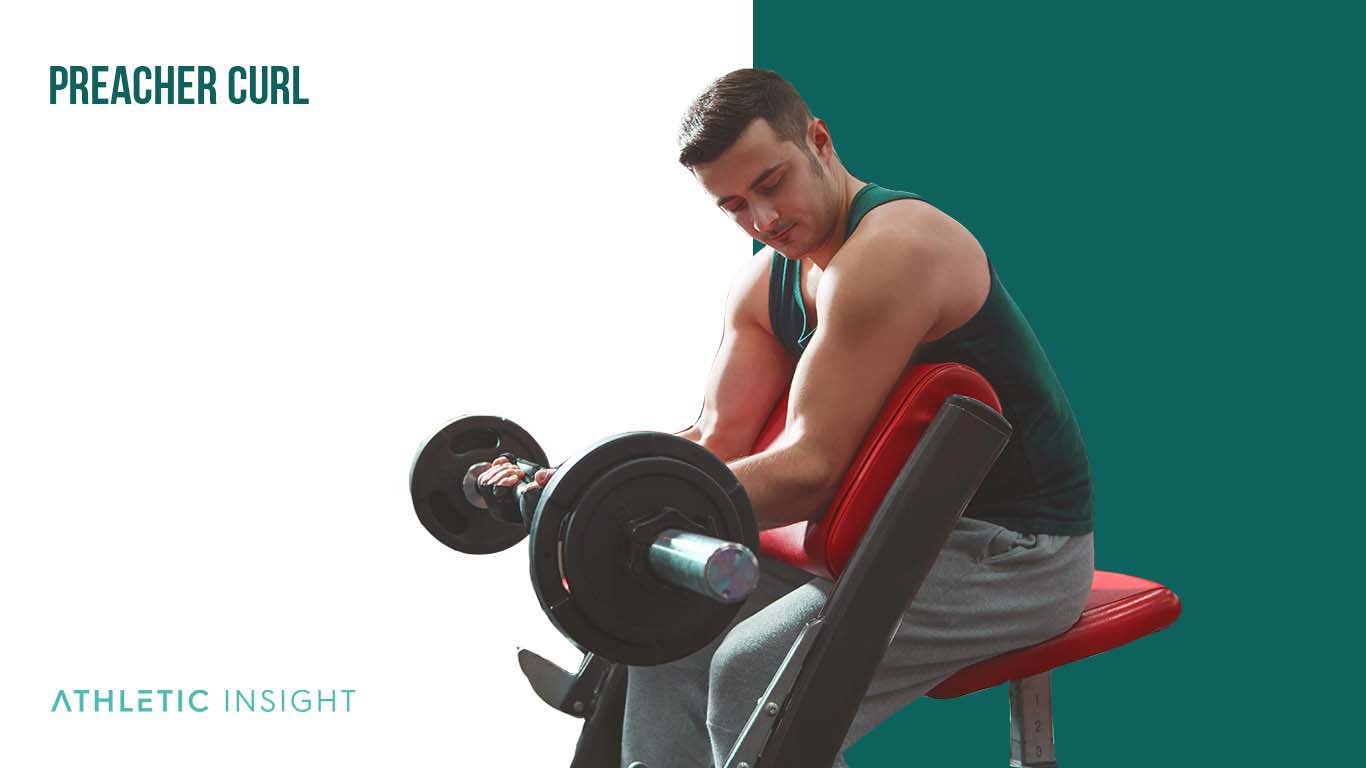Biceps curl variations are compound weight training exercises that target the biceps brachii muscles. The main bicep curls muscles worked during bicep curls include the biceps brachii, brachialis, and brachioradialis. The muscles can be worked to differing degrees based on the equipment used, form, and whether you are standing or sitting.
Beginners can use different dumbbell curl variations if they are unable to use heavier weights, such as barbells, or if they do not have equipment at home. Beginners can try resistance band bicep curls variations to make the exercise easier and to avoid any injuries caused by free weights.
On the other hand, advanced weightlifters can try more difficult types of dumbbell curls that work the shoulders, biceps brachii, brachioradialis, forest flexors, and wrists to build complete anterior arm strength. While there are many bicep curl variations, the most common ones are the barbell bicep curls, reverse curls, incline dumbbell curls, Zottman curls, and kettlebell biceps curl variations.
Bodybuilders frequently use different curl exercises to help them in other lifts and to build the muscles on the front of their arms for bodybuilding shows and aesthetics. Since different types of biceps curls work the biceps, deltoids, brachialis, brachioradialis, and the short head and long head of the biceps, this is a complete anterior arm exercise.
1. Dumbbell Concentration Curl
The dumbbell concentration curl is one of the types of bicep curls that works the biceps brachii short head, biceps brachii long head, brachialis, and brachioradialis. Since the user will have their elbow on their knee during the entire range of motion, there is no need for any other muscular stabilizers or core stabilization. Therefore, the exercise is good for bodybuilders and weightlifters who want to build the size and mass of their arms.

Alternatives of the dumbbell concentration curl include the barbell standing curl, serrated barbell curl, stated dumbbell curls alternating dumbbell curl, incline dumbbell curl lying cable curl, and standing cable curl.
One mistake to avoid during this exercise is moving your elbows off your knee. Users can prevent this mistake by keeping their head looking at their arm during the movement and pressing their forearm into the inside of their leg during the motion.
The toughness level of this exercise is a 3 out of 10 since it does not require any other muscular stabilization but does require extra concentration and form to do correctly.
2. Zottman Curl
The Zottman curl is a bicep curl variation that works the long head of the outer bicep, upper forearm, brachialis, and short head of the inner bicep. The Zottman curl is a common exercise for bodybuilders who want to build their biceps and isolate the anterior side of their arm.
Alternatives of the Zottman curl include the alternating dumbbell curl, pronated barbell curl, pronated cable curl, pronated dumbbell curl, lying cable curl, stead dumbbell curl, incline bench dumbbell curl, and seated barbell curl.
One mistake to avoid during this exercise is to move your elbows away from your body. Users can prevent this mistake by curling with their arms up and rotating the dumbbell at the top of the range of motion.
The toughness level of this exercise is a 4 out of 10 since it requires shoulder stabilization and rotating the dumbbell during the movement.
3. Kettlebell Curl
The kettlebell curl is a bicep curl variation that taxes the anterior deltoids, biceps brachii long head and short head, biceps brachialis, and brachioradialis. This exercise targets the forearms more so than other bicep curls since you’ll need to stabilize the weight due to the uneven construction of the kettlebell.

Alternatives of the kettlebell curl include the single kettlebell curl, alternating kettlebell curl, barbell curl, altering dumbbell curl, alternating seated dumbbell curl, standing cable curl, lying cable curl, and single-arm cable curl.
One mistake to avoid during this exercise is letting the kettlebell flop down during the movement. Users can prevent this mistake by keeping firm wrists and engaging their forearms.
The toughness level of this exercise is a 5 out o f10 since it requires more forearm and wrist strength.
4. Reverse curl
The reverse curl is a bicep curl variation that engages the biceps brachii, brachialis, and brachioradialis. Since this exercise uses a pronated grip instead of a supinated grip, the perverse curl works the forearms and the brachialis more so than the typical bicep curls. This exercise is good for athletes who use barbells a lot in their lifting to improve their grip strength.
Alternatives of the reverse curl include barbell reverse curl, EZ bar reverse curl, cable reverse curl, straight bar reverse grip curl, dumbbell curl, kettlebell curl, and single-arm kettlebell curl.
One mistake to avoid during this exercise is not wrapping your thumb around the bar or the dumbbells. Users can avoid this mistake by touching their thumb to their other fingers and keeping a firm grip during the entire movement.
The toughness level of this exercise is a 4 out of 10 since it requires extra forearm and grip strength.
5. Cable Curl
The cable curl is one of the curl variations that work the brachialis, bicep, and brachioradialis. This exercise is good for athletes who want constant tension on their shoulders and arms during the entire motion to build complete upper-body coordination and strength.
The alternatives of the cable curl include the pronounced cable curl, barbell curl, dumbbell curl, resistance-band curl, and EZ bar curl.
One mistake to avoid during this exercise is letting the weights slam down at the end of the range of motion. Users can avoid this mistake by keeping constant tension and a firm grip on the cable.
The toughness level of the cable curl is a 4 out of 10 due to the muscular endurance required.
6. Incline Dumbbell Curl
The incline dumbbell curl is a bicep curl variation that works the biceps more so than the brachialis and brachioradialis due to the angle of the weight being lifted. This exercise is good for weightlifting and bodybuilders who want to focus primarily on their biceps.
Variations of the incline dumbbell curl include the incline cable curl, incline EZ bar curl, incline barbell curl, seated dumbbell curl, and alternating incline dumbbell curl.
One mistake to avoid during this exercise is bringing your head off the bench. Users can prevent this mistake by keeping their bodies firmly on the bench and only moving at their elbows.
The toughness level of the incline dumbbell curl is a 4 out of 10 since users’ bodies will be supported during the entire motion, but it requires more focus on the biceps.
7. Preacher Curl
The preacher curl is one of the main bicep curl variations that work the biceps primarily, with the secondary muscles being the brachialis and forearm flexors. This exercise is good for weightlifting and bodybuilders who want to focus on their biceps and isolate this muscle.

The alternatives of the preacher curl include preacher dumbbell curl, preacher EZ bar curl, preacher barbell curl, alternating dumbbell preacher curl, cable curl, and incline dumbbell curl.
One mistake to avoid during this exercise is to bring your forearms off of the pad. Users can avoid this mistake by only hinging at the elbows and keeping their wrists locked.
The toughness level of the preacher curl is a 4 out of 10 due to the constant forearm tension.
8. Biceps Curl Machine
The biceps curl machine is a bicep curl variation that works the biceps brachii outer head, biceps brachii inner head, brachialis, and brachioradialis. The main focus of this machine is the biceps and the forearms. This exercise is helpful for beginners who do not want to use free weights.
Alternatives of the biceps curl machine are the preacher curl, standing barbell curl, standing dumbbell curl, seated dumbbell curl, resistance-band curl, and EZ bar curl.
One mistake to avoid during this exercise is bringing your arms off the pad. Users can prevent this mistake by keeping their elbows planted on the pad and their heads facing forward.
The toughness level of this exercise is a 3 out of 10 since the weights are on a track and the machine is easy to use.
9. 21s
The 21s are a bicep curl variation that works the short biceps head, biceps long head, brachialis, and brachioradialis. For those who want to try different bicep curls, this exercise is suitable for upper-body athletes who wish to build endurance or bodybuilders who want to reach muscular failure during this endurance exercise.
Alternatives of this exercise include half-rep bicep curls, barbell curls, 21s with the barbell, 21s with the cable, 21s with the EZ bar, and 21s on the preacher curl set-up.
One mistake to avoid during this exercise is not going through the full range of motion. Users can prevent this mistake by focusing on including both lower reps and upper reps.
The toughness level of this exercise is a 6 out of 10 since it requires more muscular endurance and tension.
10. Hammer Curls
Hammer curls are one of the bicep curl variations that work the brachialis and the brachioradialis forearms more so than the biceps. The secondary muscles are the biceps and the anterior deltoid. This exercise is good for upper-body athletes who want to also work the shoulders during the bicep curls.
Alternatives of the hammer curls include cable hammer curls, kettlebell hammer curls, barbell curls, rope hammer curls, and incline bench curls.
One mistake to avoid during this exercise is not going through a full range from Austin and rotating your wrist. Users can prevent this mistake by keeping their palms facing one another and touching the weights on their shoulders.
The toughness level of this exercise is a 4 out of 10 since it has easy form and does not require an extensive range of motion.
11. Band Bicep Curl
The band bicep curl is a bicep curl variation that works the deltoids, biceps brachii, brachialis, and brachioradialis. This exercise is so good for those who have shoulder limitations and for beginners who do not feel comfortable using heavier weights in the gym.
Alternatives to his exercise include the EZ bar curls, dumbbell curls, hammer curls, barbell curls, cable curls, and rope cable curls.
One mistake to avoid during this exercise is not keeping your palms facing upwards. Users can avoid this mistake by keeping their chest upright and only hiding at their elbows.
The toughness level of this exercise is a 3 out of 10 since it is easy to use and easy to learn but requires more muscular endurance due ott the constant band tension.
12. Plate Curl
The plate curl is a bicep curl variation that works the forearm and wrists more so than other exercises. Since the user will have to grab the plate with a pronounced grip or palms facing one another, it can tax the brachialis and forearm more so than the typical bicep curl.
Alternatives of the plate curl include the kettlebell curl, dumbbell curl, hammer curl, barbell curl, and resistance band curl.
One mistake to avoid during this exercise is letting your wrists go limp. Users can prevent this mistake by keeping firm wrists and keeping tension on their forearms.
The toughness level of this exercise is 4 out of 10 due to the focus on the brachioradialis and brachialis.
13. Fat Grip Bicep Curl
The fat grip bicep curl is a bicep curl variation that places more strain on the forearms and wrist due to a lack of grip on the bar. Weightlifters and bodybuilders will use this exercise to build their anterior arms.
Alternatives of the fat grip bicep curl include the fat grip EZ bar curl, EZ bar curl, dumbbell curls pronounced dumbbell curls, and fat grip cable curl.
One mistake to avoid is slipping off of the bar. Users can avoid this mistake by increasing their grip strength before this exercise and printing ahead of time.
The toughness level of this exercise is a 6 out of 10 due to the extra grip strength required.
14. Spider Curls
Spider curls are a bicep curls variation that works the biceps primarily. Since nurses will be supported on the bench during the entire range of motion, this is a good exercise for bodybuilders who want to target and isolate their biceps.
Alternatives of the spider curl exercise include the hammer curl, dumbbell curls, barbell curls, and incline dumbbell curls.
One mistake to avoid is to bring your chest off the bench. Users can prevent this mistake by keeping their heads in line with their bodies and only hinging at their elbows.
The toughness of this exercise is a 4 out of 10 since users will not need to stabilize with their core.
15. High-Pulley Cable Curl
The high-pulley cable curl is a bicep curl variation that works the biceps brachii and brachialis. The higher angle of the bicep curl targets the brachialis and biceps more so than other exercises and can be suitable for bodybuilders.
Alternatives of the high-pulley cable curl include the low-pulley cable curl, rope curl, EZ bar curl, and dumbbell curl.
One mistake to avoid with this exercise is leaning on your upper body. Users can avoid this mistake by keeping their shoulders level and their head facing forward.
The toughness level of this exercise is a 6 out of 10 since it requires better form and more core stabilization.
What to know about Dumbbell Bicep Curls variations?
The dumbbell bicep curls variations are suitable for beginners who need to modify the exercise due to injury or lack of confidence in the gym. Furthermore, this can be good for athletes or bodybuilders who want to target specific muscle groups.
What are the common mistakes in doing the Dumbbell Bicep Curls Variations?
The common mistakes in doing the dumbbell bicep curls variations are moving your entire body, not insulating the exterior of your arm, choosing a weight that is too heavy, and not following proper form.
Which type of Dumbbell Bicep Curls variation is beginner-friendly?
The best beginner-friendly dumbbell bicep curls variations are the dumbbell concentration curl, cable curl, and biceps curl machine.
Which type of Dumbbell Bicep Curls variation is good for weightlifters?
The best dumbbell bicep curls variations for weightlifters are the Zottman curl, reverse curl, preacher curl, 21s, and the fat grip bicep curl.
Which type of Dumbbell Bicep Curls variation is good for athletes?
The best dumbbell bicep curls variations for athletes are the band bicep curl, incline dumbbell curl, and kettlebell curl.
Which type of Dumbbell Bicep Curls variation is good for bodybuilders?
The best variations for bodybuilders are the high-pulley cable curl, fat grip bicep curl, plate curl, and preacher curl.
Which Bicep Curl Variation is more Difficult?
The most difficult bicep curl variations are the Zottman curl, reverse curl, preacher curl, 21s, fat grip bicep curl, and high pulley cable curl.
What are the alternatives of Dumbbell Bicep Curls Exercises?
Rather than mention each alternative, here is a list of the alternatives to Dumbbell Bicep Curls.
- Dumbbell Concentration Curl
- Zottman Curl
- Kettlebell Curl
- Reverse Curl
- Cable Curl
- Incline Dumbbell Curl
- Preacher Curl
- Biceps Curl Machine
- 21s
- Hammer Curls
- Band Bicep Curl
- Plate Curl
- Fat Grip Bicep Curl
- Spider Curls
- High-Pulley Cable Curl



